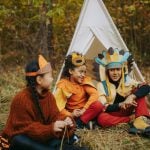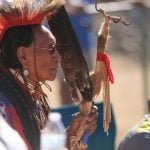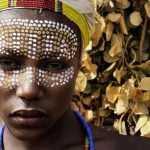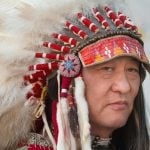Indian Tribes of the Great Basin Culture Area
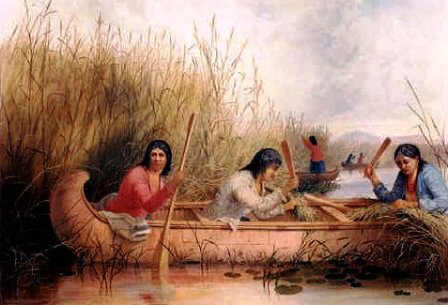
The Great Basin Culture Area includes the high desert regions between the Sierra Nevada and the Rocky Mountains. It is bounded on the north by the Columbia Plateau and on the south by the Colorado Plateau. It includes southern Oregon and Idaho, a small portion of southwestern Montana, western Wyoming, eastern California, all of Nevada and Utah, a portion of northern Arizona, and most of western Colorado. This is an area which is characterized by low rainfall and extremes of temperature. The valleys in the area are 3,000 to 6,000 feet in altitude and are separated by mountain ranges running north and south that are 8,000 to 12,000 feet in elevation. The rivers in this region do not flow into the ocean, but simply disappear into the sand.
With regard to Great Basin ecology, Christopher Chase-Dunn and Helly Mann, in their book The Wintu and Their Neighbors: A Very Small World-System in Northern California, report:
“It is an ecologically sparse environment punctuated by small areas where water, game, and plant life are abundant.”
In her book Indians of the Plateau and Great Basin, Victoria Sherrow reports:
“Summers in a Basin desert can be fiercely hot, the winters bitterly cold. The land is unfavorable for farming and contains little game for food.”
This is an area which seems inhospitable to human habitation, yet Indian people have lived here for thousands of years. This was the last part of the United States to be explored and settled by the European-Americans. In writing about the early Indian settlement of the Great Basin, archaeologist Jesse Jennings, in his book Prehistory of Utah and the Eastern Great Basin, notes:
“Effective human exploitation of the American Desert West requires rather intimate knowledge of a fairly large territory of several hundred square miles, a territory probably encompassing the full range of desert biomes or ecologic communities.”
Language
Linguistically all of the Indian people of the Great Basin, with the exception of the Washo, spoke languages which belong to the Numic division of the Uto-Aztecan language family. The Numic languages appear to have divided into three sub-branches—Western, Central, and Southern—about 2,000 years ago. About a thousand years ago, the Numic-speaking people expanded northward and eastward.
Tribes
The basic tribes of the Great Basin Culture Area include Bannock, Gosiute, Mono, Northern Paiute, Panamint, Shoshone, Southern Paiute, Washo, and Ute.
The Ute were never a single unified tribe. There are several bands of the Ute:
(1) the Weminuche (Weeminuche) or Ute Mountain Ute whose homeland is the San Juan drainage of the Colorado River,
(2) the Tabeguache (also known as Uncompahgre),
(3) the Grand River band,
(4) the Yampa whose homeland is in northwestern Colorado,
(5) the Uintah whose homeland ran from Utah Lake east through the Uinta Basin,
(6) the Muache (Moache) whose homeland ranged south along the Sangre de Cristos as far south as Taos,
(7) the Capote of the San Luis Valley and the upper Rio Grande,
(8) the Sheberetch in the area of present-day Moab,
(9) the Sanpits (San Pitch) in the Sanpete Valley in central Utah,
(10) the Timanogots near Utah Lake,
(11) Pahvant who lived in the deserts surrounding Sevier Lake, and
(12) the White River (Parusanuch and Yamparika) in the White and Yampa River systems of Colorado.
The Shoshone are often divided into four general groups: (1) the Western Shoshone who lived in central Nevada, northeastern Nevada, and Utah, (2) Northern Shoshone who lived in southern Idaho and adopted the horse culture after 1800, (3) Eastern Shoshone of Wyoming who adopted many of the traits of Plains Indian culture, and (4) Southern Shoshone who live in the Death Valley area on the extreme southern edge of the Great Basin.
The Northern Shoshone groups include the Fort Hall Shoshone, the Lemhi Shoshone, the Mountain Shoshone, the Bruneau Shoshone, and the Boise Shoshone. The Lemhi Shoshone hunted buffalo in western Montana, but depended primarily upon salmon for their subsistence. The Bruneau Shoshone were not a horse people and depended largely on salmon and camas. The Boise Shoshone also used salmon and camas as primary foods and also hunted buffalo in Wyoming and Montana.
Shoshone bands, like other groups in the Great Basin and Plateau Culture Areas, were often named after their dominant food source. Thus mountain-dwelling Shoshone were known as Tukudika (“eaters of bighorn sheep” or sheep eaters). Other Shoshone groups include the Agaidika (salmon eaters), Padehiyadeka (elk eaters), Yahandeka (groundhog eaters), Pengwideka (fish eaters), Kamuduka (rabbit eaters), Tubaduka (pine-nut eaters), and Hukandeka (seed eaters), and the Kukundika (also spelled Kutsundeka; buffalo eaters).
The Shoshone (also spelled Shoshoni) take their name from the Shoshone word sosoni’ which refers to a type of high-growing grass. Some of the Plains tribes referred to the Shoshone as “Grass House People” which referred to the conically shaped houses made from the native grasses. Some Plains groups also referred to them as the “Snakes” or “Snake People”. This term comes from the sign which the people used for themselves in hand sign languages. Drusilla Gould and Christopher Loether, in their book An Introduction to the Shoshoni Language: Dammen Daigwape, write:
“The hand motion made for the sign represents a snake to most signers, but among the Shoshoni it referred to the salmon, an unknown fish on the Great Plains.”
The Shoshone often refer to themselves as newe.
The Bannock, who call themselves Bana’kwut (“Water People”), were called Buffalo Eaters and Honey Eaters by other tribes.
At one time, the Bannock lived in the desert areas of southeastern Oregon. They later migrated into the Snake and Lemhi River valleys where they came in contact with the Shoshone. The two groups shared many cultural elements and their languages are related. In his book The Shoshone-Bannocks: Culture and Commerce at Fort Hall, 1870-1940, Historian John Heaton writes:
“Shoshones spoke Central Numic, whereas Bannocks, who began to intermarry with Shoshones in Idaho in the early eighteenth century, spoke Western Numic.”
With intermarriage, many became bilingual. Today the term Sho-Ban is used to refer to the two tribes.
Bannock culture tended to emphasize war more than Shoshone culture. With regard to the merger of the Shoshone and Bannock, historian John Heaton writes:
“Bannock warriors generally emerged as the most influential leaders of the equestrian Shoshone-Bannock bands.”
The traditional homeland of the Gosiute was south and west of Great Salt Lake. They lived in the Tooele, Rush, and Skull valleys. In his book Basin-Plateau Aboriginal Sociopolitical Groups, Julian Steward feels that the Gosiute are linguistically and culturally Shoshone.
There are fifteen Southern Paiute bands: Chemehuevi, Las Vegas, Moapa, Paranigat, Panaca, Shivwits, St. George, Gunlock, Cedar, Beaver, Panguitch, Uinkaret, Kaibab, Kaiparowits, and San Juan.
In the northern part of the Great Basin, the bands tended to call themselves after a particular food source: “salmon eaters,” “mountain sheep eaters,” and so on. In the south, the band names tended to be geographical.
Migrations
The linguistic and archaeological data seem to suggest that the Numic-speaking people spread into the Great Basin from southeastern California.
The homeland of the Numic-speaking groups in the Great Basin is generally seen as the Death Valley area. Linguistic data seems to suggest that these groups began their migrations from this area into other parts of the Great Basin about 1,000 to 1,500 years ago. In an article in the Utah Historical Quarterly, Catherine and Don Fowler report:
“Archaeological and linguistic evidence indicates that the Numic-speaking peoples spread across the Great Basin sometime after A.D. 1000, displacing or replacing the earlier carriers of the Fremont and Virgin Branch Anasazi cultures in Utah, eastern Nevada, and Northern Arizona.”
In an article in American Antiquity, Angus Quinlan and Alanah Woody report:
“Indications of a late Numic spread into the western Basin can be found in some Numic oral traditions, though other oral histories insist that Numic groups have occupied the Great Basin from the beginning of time.”
One Northern Paiute oral history tells of driving off an earlier group in western Nevada. A Southern Paiute oral tradition tells of an earlier group identified as the “Mukwic” who were responsible for the pictographs in the area.
